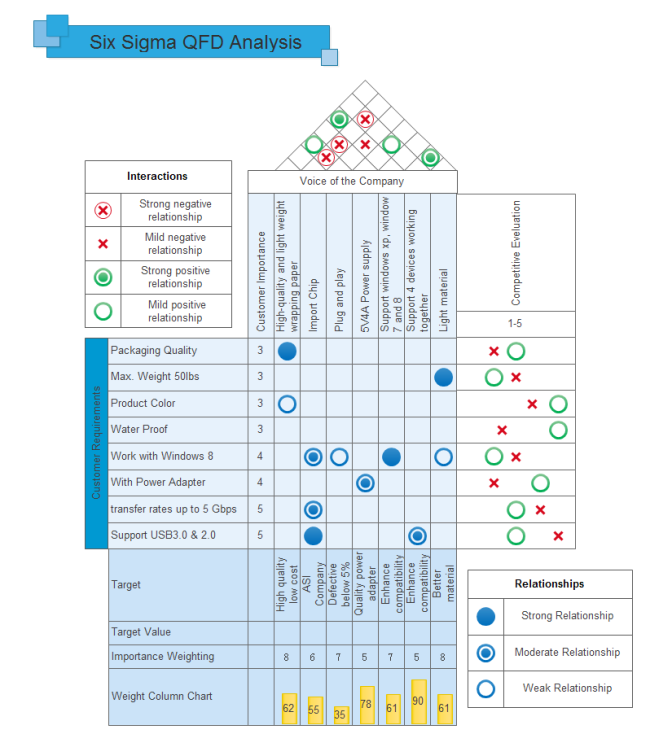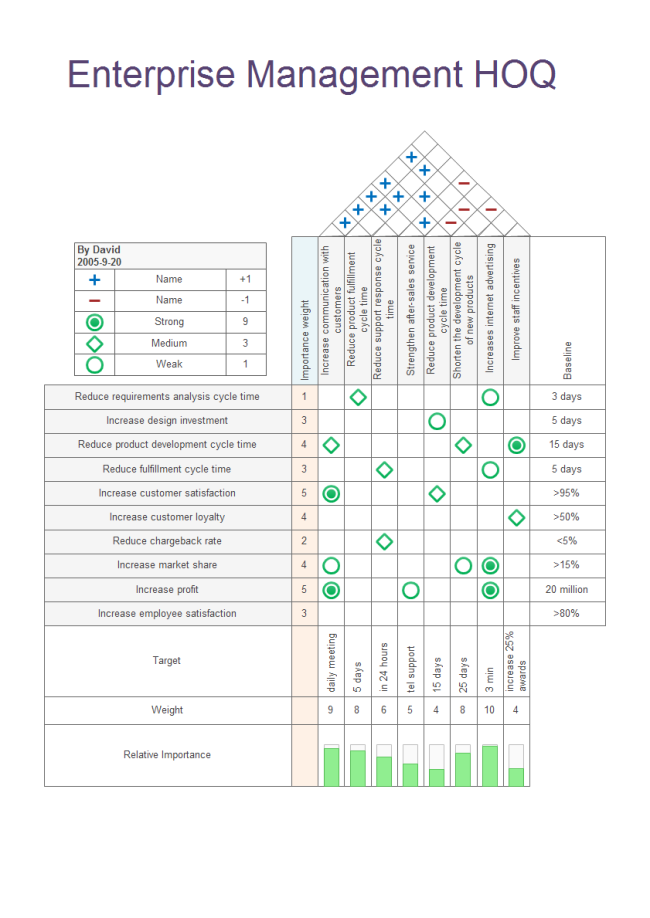What is Six Sigma? - A Simple Guide for You
Contents
- Six Sigma Basic Definition
- Six Sigma History Overview
- More about the Advantages of Using Six Sigma Methodology
- Are there any Reminders of Using Six Sigma?
- Six Sigma Empirical Applications
- What are Six Sigma Belts?
- How to Carry out a Six Sigma Analysis?
- More Free Templates
- How to Create a Six Sigma Matrix and a DMAIC Diagram?
Six Sigma Basic Definition
To be simple, Six Sigma is a disciplined approach for organizations to improve production process or service stability (e.g. the waiting time when different customers are calling a call center), reduce costs, eliminate defects, and deliver good customer service by analyzing statistical information. The standard metric requirement of Six Sigma is 3.4 defects per million opportunities, which means, for example, 3 or 4 low-quality products in one million produced. In order to apply the Six Sigma methodology, you need to have a deep understanding of cross-subjects including customer needs, data, statistical analysis, business management and so on. Below is a Six Sigma example in the RACI matrix, which displays the software development process (click on it to enlarge the image).
Free Download Edraw Max to Find out more preset Diagram Resources
Six Sigma History Overview
The term Six Sigma came from the statistical modeling of manufacturing processes and sigma ratings are used to describe the maturity of a manufacturing process. The theory was first introduced by Walter Shewhart in the 1920s. Several decades later in 1980, Motorola engineers Chairman Bob Galvin and Bill Smith developed a new measurement standard (measure the defects per million products) of Six Sigma for all of the manufacturing process within their company. Actually, Six Sigma is also a federally registered trademark of Motorola. In 1995, Six Sigma was known and used as a business strategy by General Electric. So far, Six Sigma has evolved for many times. Now it is not only a quality system, but also a new way of analyzing and developing business.
More about the Advantages of Using Six Sigma Methodology
The methodology is mainly used to:
- Strengthen the understanding of project details, such as financial benefits, product advantages and features of organizational processes.
- Improve production processes metrics to speed up production cycle time.
- Help ensure a long-term stability for further upgrades of products. This also helps organizations create a closed feedback loop for their products or services.
- Gain hands-on Information for Industrial projects, which may involve the Quality Function Deployment (QFD).
Are there any Reminders of Using Six Sigma?
Everything has two sides, so does the Six Sigma methodology. Therefore, you should be careful with the following points when applying the approach to your project.
- For complex or large-scale projects, you may also consider some other analysis tools as a supplement.
- For the research and development of new products, especial those advanced technology ones, the use of Six Sigma may have a negative impact on exploring new factors.
- The use of Six Sigma can't leave statistic analysis, but try not to rely too much on its statistic parts. The use of multiple regression techniques could increase the risk of making commonly unknown statistical errors.
Six Sigma Empirical Applications
Six Sigma techniques so far have been applied in a wide range of industries and fields including aerospace, electronics, banking and finance, information technology, human resource management, marketing, and many more. Here is an example of enterprise management. Feel free to click on it to see insights.
Here we gonna look at more real-time cases:
Manufacturing
Around 2000, General Electric announced that Six Sigma methodology helped the organization saved millions of US dollars (according to GE annual report). Later, more international enterprises use the approach to waste reduction.
Construction
Six Sigma methodology can be used to control building quality of international hotels or apartments, and to increase the production of heavy industrial materials such as steel. The construction time can also be reduced by using the methodology to prevent rework.
Finance Sector
Financial managers of many worldwide investment banks or financial institutions use Six Sigma approach to improve the accuracy of cash allocations, reduce documentary credits defects and improve the weak financial streamline operations.
Logistics
Using Six Sigma can ensure good quality products be delivered in time by adjusting the schematic information for different delivery centers.
Public Sector
Six Sigma can also be applied to public services, such as frameworks, healthcare institutions and roadway companies, to reduce equipment costs, alter the preparation process and provide safe services to the public.
What are Six Sigma Belts?
In Six Sigma, the term "Belt" is used to signifies different levels of management experience of employees. There are four belt titles in total (from low to high): Yellow, Green, Black, and Master Black. The higher the level of an employee, the more Six Sigma training and skills (e.g. be able to use statistical tools) the employee has. Let's explore more details of these belts now:
Yellow Belt
Employees who have the yellow belt normally have basic knowledge about main Six Sigma methodologies and statistical tools, but the role may not join the analysis of the system. Yellow belt employees are usually assigned to measure the phase of their projects and gather measurements metrics and data sets.
Green Belt
Employees who have the green belt usually report work progress to a black belt staff for large and complex project problems. Green belt employees normally have good knowledge about different Six Sigma approaches and good team problem-solving skills, but they may not have experience with advanced statistical models.
Black Belt
A professionalist who have the black belt is trained at the highest level of all Six Sigma concepts, statistical knowledge and skills. Black belt staffs also create project plans, lead and train the whole team based on Six Sigma tools and skills.
Master Black Belt
Staffs who have the master black belt normally mentor, train and lead team members including black belt employees. These people also have widespread project management knowledge and rich successful project experiences.
How to Carry out a Six Sigma Analysis?
Although Six Sigma strategies may vary a lot between different firms because of their specific organizational cultures and business goals, there are three common methods for the use of a Six Sigma approach:
-
DMAIC (Define, Measure, Analyze, Improve and Control); It is an improvement system for existing processes.
- DMADV (Define, Measure, Analyze, Design and Verify); It is an improvement system used to develop new processes or products. The overall analysis process of DMADV is similar to DMAIC.
- LSS (Lean Six Sigma); It is a new methodology that integrates both Six Sigma principles and Lean concepts to decrease process variation and reduce waste. Lean, which also be called as Lean Methods, is a series of techniques mainly used to reduce the waste that generated from the flow of materials in an overall process. Sometimes, you may also need value stream mapping to gain more process details.
The most popular one among all these sub-category Six Sigma methodologies is DMAIC (as shown in the diagram below). Simply see the following steps to apply this approach and click on the image to check out more details.
Step 1: Define Your System
Your team should first draft a problem statement with clear and full details, for example, the quality requirement etc. Then you should define a clear project scope to keep the whole team focused on important issues. To do so, you may need to integrate the SIPOC methodology with the DMAIC method to clearly understand the purpose of your project. Next, you should identify project resources by assigning team members to different tasks. Finally, you should also develop a project plan with information such as in what way the project will be finished.
Step 2: Measure Key Factors
Now, your team should completely analyze the current state of the project and creates a baseline for the system by developing detailed process maps and data collection plans (what, how often, and how many etc.). It is better to collect your datasets on process performance over a certain period of time and then recheck your data sets.
Step 3: Analyze the Gained Data to Find out Root Causes
You can do this step by using scatter plots and statistical models to identify and determine all possible root causes of the problem. Here, a cause and effect fishbone diagram with a series of sub-branches (man, material, method, machine, measurement and environment) is a good analysis tool for you.
Step 4: Improve the Current Process
It is time to improve your current process according to your data analysis by using techniques, such as brainstorming and risk-checking.
Step 5: Control and Monitor the Future State Processes
You should do this on a regular basis to ensure that any mistakes are corrected and the desired quality level is obtained. In this case, the PDCA methodology is a great choice for you to gain continuous feedback for improvement. Next, update the process documentation with any changes due to the improvements. Also, make sure that all staffs related to the process understand the changes to the system.
More Free Six Sigma Templates
Free download templates are available below to help your team to do a better Six Sigma analysis. Click on any of their names to see more details.
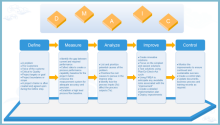
|
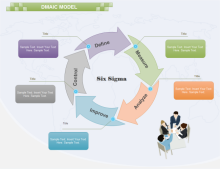
|
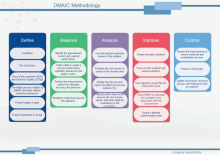
|
| DMAIC General Template | DMAIC Model Template | DMAIC Diagram Template |
How to Create a Six Sigma Matrix and a DMAIC Diagram with Software?
Besides draw these diagrams and matrix by hands, you can also try an easy diagram software for your work to improve productivity! Here are quick steps to show you how to do so:
Create a Six Sigma Matrix with Software
Step 1: Open Edraw Max and go to Project Management > House of Quality (HOQ), or go to Business Diagram > Six Sigma Matrix, then you can double-click the icon to start your work. Alternatively, you can directly choose a preset editable template from the Examples section.
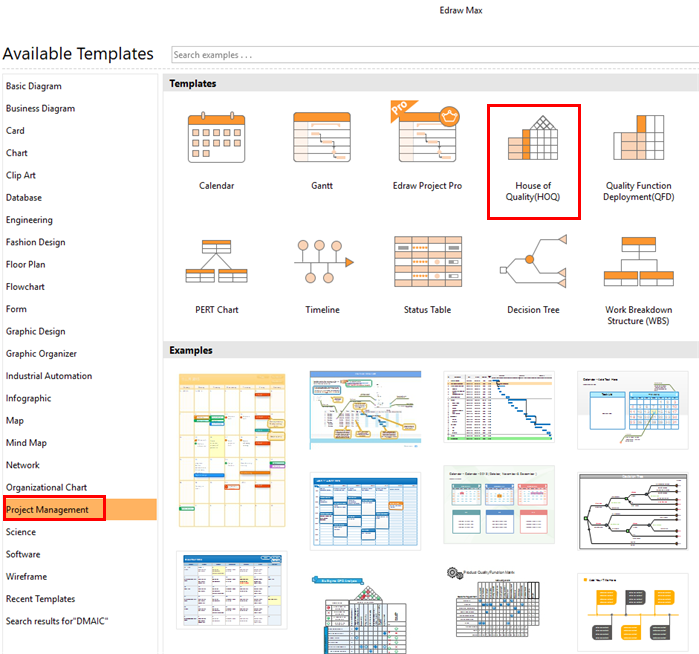
Step 2: Drag and drop an entire built-in editable matrix from the left-hand Libraries to the right-hand blank drawing board.

Step 3: Move your mouse on the blue icon as shown below to select a series of editing options on the pop-up list, for example, add or delete a row etc.
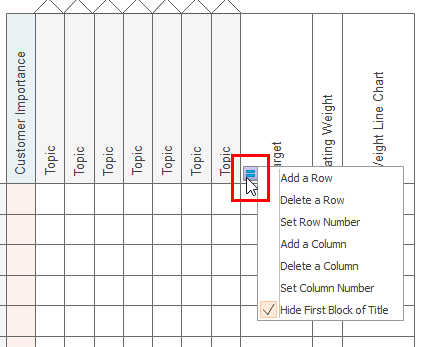
Step 4: Double-click the default text in the matrix template to replace it with your own content.
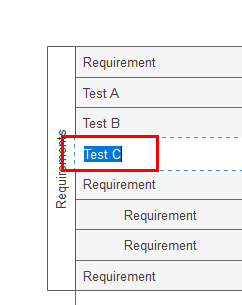
Step 5: Drag and drop any preset icons from the left-hand Libraries to your matrix, then move your mouse on the blue icon again to change the shape style of your icons.
![]()
Step 6: Save your files on the Edraw cloud, or export to different formats including MS Office, PDF, MS Visio, Graphics and so on.
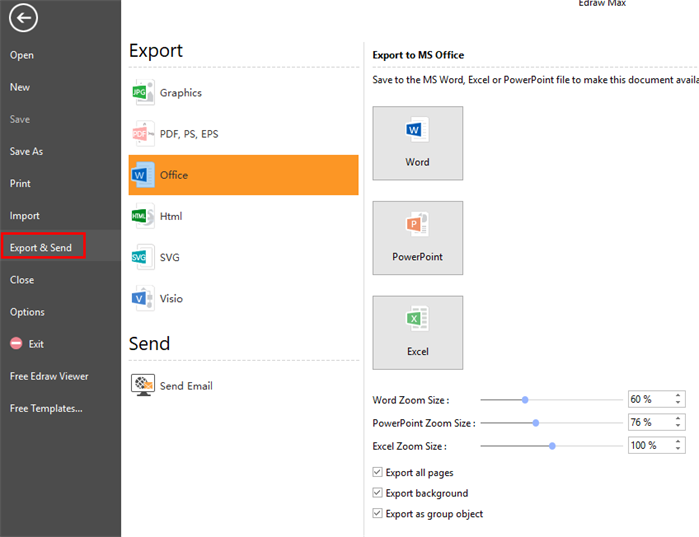
Create a DMAIC Diagram with Software
Step 1: Again open Edraw Max and go to Business Diagram and then double-click one of the preset editable templates to start your work right away.
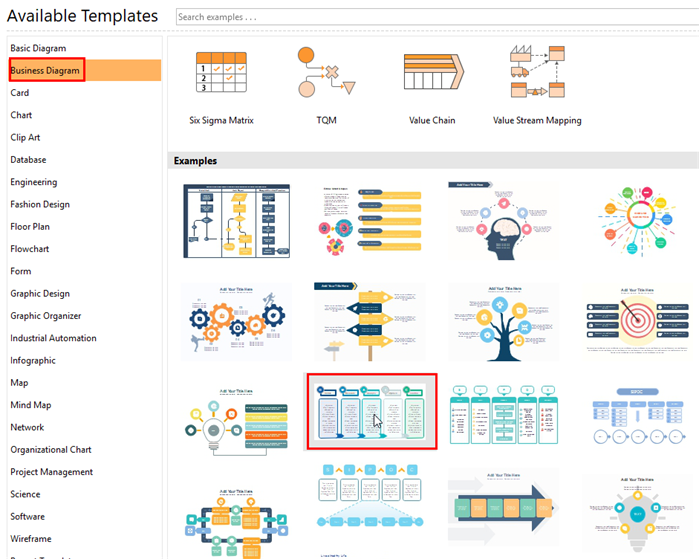
Step 2 (Optional): If you want to add more shapes and boxes for your diagram, just drag and drop editable list shapes from the left-hand Libraries to the right-hand drawing board.
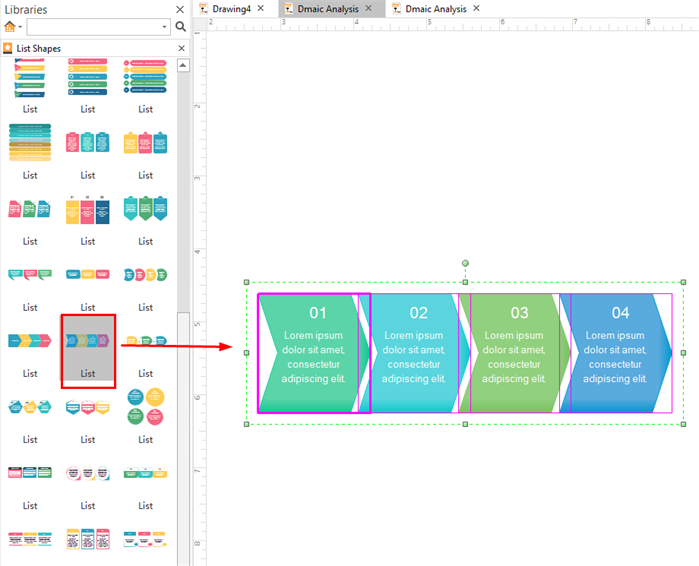
Step 3: Replace the default text with your own information by double-clicking on the text area.
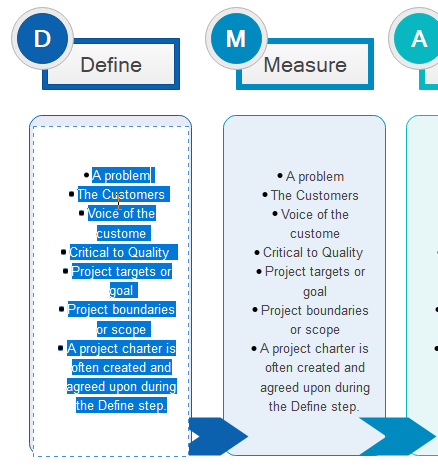
Step 4 (Optional): Use the built-in auto-create tool to quickly change your diagram theme, color, text fonts and shadow effects etc. Once done, you can choose to save, print or export your work as guided above.

It's Your Turn to Try Edraw Max
Use the cross-platform diagram and chart design software Edraw Max for a handy solution. Feel free to create both the DMAIC diagram and the Six Sigma matrix or chart by using the preset template. Furthermore, you can edit and personalize the style of your work based on many built-in auto-create tools and editable symbols. Once finished, you can save files on Edraw cloud or export to a wide range of formats including MS Office, Graphics and MS Visio.
Explore More:
How to Apply Six Sigma Analysis with Brainstorming?
